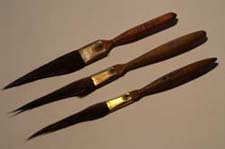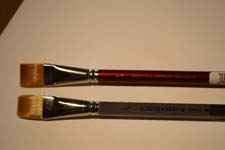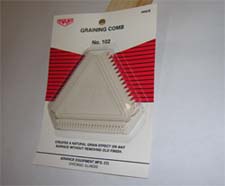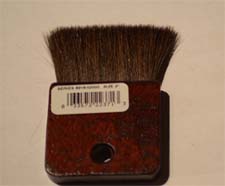|
|
|
Product Information: Catalog A-H
Catalog A-H |
Catalog I-P |
Catalog Q-Z |
Extras |
Miscellaneous |
Specialty Items
|
|
Aerosol Sprays
|

|
|
Jet Spray Lacquers are specially formulated for finished or unfinished areas to be
touched-up, shaded and finished with ease. Two to three light coats of the desired
sheen develops a durable, alcohol resistant finish. Sanding Sealer is quite versatile
and enables leveling and build-up of solids for final top-coating as well as sealing
in stains or dyes. Sanding Sealer fills in and levels surface scratches, burn-in
repairs, fast drying and seals in stains. Crackle Lacquer / Antique Finish is used to
"antique" with a crackled appearance. Any Jet Spray can be used as a base color for
crackling. Blush Eraser eliminates blushing from humid, damp or cold climate work,
but does not change existing color or sheen. Lacquer Leveler is used to smooth and level
an orange-peeled lacquer finish. Can re-flow the finish as well as release moisture
from blushing. (Gloss Lacquer) No fluorocarbons. 15 oz.
|
|
|
Brushes
|

|
The value of a brush depends entirely upon the quality of the materials used, the
method of construction and its correct use. Good brushes may seem to be expensive
initially: however, the quality of the finish largely depends on the quality of
the brush and contributes to the brush's longevity. Brushes are composed of 4 parts;
the handle, the ferrule, the stock and the setting. Handles are usually hardwood;
the setting is how the stock is set into the handle. The ferrule, often steel, nickel
or tin connects the handle to the stock. And the stock is the working part of the
brush. The following brushes are of the highest quality. Winsor-Newton Golden
Nylon/Grumbacher Golden Edge: Handmade, works like fine sable. Holds sharp point
and chisel edges for precise detail work and blending. The #1 choice for shellac.
Badger brushes: Pure badger hair mixed with pure white skunk and hog bristles to a
chiseled edge. Good to apply varnish, shellac lacquer or enamel. Excels in
all general and staining work. A flowing and blending brush. Red Sable: Composed of
Red Sable, one of the best brush hairs. Best quality for touch-up work.
Rust-proof ferrule.
Dagger Stripers have sharp,
clean edges with perfect points. Fine White Bristle Stencil Brush in metal ferrule.
Wax brushes are helpful for applying waxes and in the rubbing out process.

Our brushes are made of the finest materials and will give long wear with proper care.
Remove loose bristles when new by gentle tapping on palm of hand. Load brush slowly,
allowing it ample time to absorb the material. Remove excess material by drawing brush
flat across can, NOT edgewise! Use the right brush for the right job. Always clean
immediately after use. Wash in hot water and neutral soap, rinse and shake out excess
water. Let dry thoroughly and store in wrapped paper. If used as a shellac brush,
clean with alcohol, smooth out the bristles and let dry in a horizontal position. B
rush will remain stiff until next use when it softens in alcohol. With care, your
fine brushes will last a lifetime.
Additional brushes can be special ordered upon request (Floggers, Blending, Overgrainers,
Mottlers, Stipplers). Also see Gilding Brushes.

Absolutely the BEST for dedicated shellac work! Keep this brush strictly for shellac work. Rinse in alcohol before its first
use to remove any residual material used in shipping and storage. When done using it -only in shellac- lightly wash it in alcohol, re-smooth
hairs with your hand, let dry flat and then store upright until the next time to use. The hairs will stiffen from residual shellac left
behind from the light alcohol wash, and will keep the brush in top working condition for a very long period of time. When ready to use again,
just wet in alcohol to loosen the old shellac in the hairs and the brush is then ready to be used again! And again and again!!
|
|
|
Crackled Finishes
|

|
|
There has been a lot of interest in recreating the old crazed
or crackled finish so well appreciated on antiques. Application
of a patina can be achieved in a variety of ways. Here are some
suggestions. Crackle Lacquer/Antique Finish is
nitrocellulose-based lacquer, flammable, and yields good crackling
effects. Available in 15oz aerosols only. Apply over dyes, stains,
bare wood, or oil or water base paints when first sealed with
a clear lacquer coat. Crackle Lacquer Clear allows
for quick creation of cracked, crazed or antique looking finish.
Spray a wet coat over a dried nitrocellulose base coat. Offered
in ready to spray clear consistency. May be colored with Master
Colors (see Stains). Requires standard lacquer spray set-up. Available
in quarts and gallons only, not in aerosols! Cannot ship
gallons, in-store purchase only.
|
|
|
Dyes and Colorants
|

|
The process by which solid wood or veneer is colored is termed Dyeing.
This may be done to make an inferior wood appear to be a "better" wood, to match colors,
or to add a decorative touch to a surface. There are several major methods of dyeing wood.
The first kind uses pigmented products, more commonly known as Stains,
where oil is combined with certain colored pigments. These tend to mask the natural grain
of the wood, are light-fast, easy to use, quick drying and non-grain raising. See
Stains. The second kind of dyes are Anilines. These synthetic coal-tar
derivatives are relative newcomers to the finishing arena. They are relatively inexpensive,
easy to use, and provide many colors. See below. A third way to color wood is with
Solar-Lux (NGR) Dyes. They are commercially prepared solutions composed
of dyes and solvents that are Non-Grain Raising. They have the clarity and lightfastness
of water soluble dyes and the non-grain raising abilities of alcohol soluble dyes. UV
Resistant. A fourth and fifth kind of dyeing are composed of Natural Dyes, Chemical
Dyes and Mordants. An exciting technique to color wood is available at Olde Mill.
Olde Mill Fast-Sol Dyes. Solvent Soluble, UV Resistant Dyes are composed
of a range of metal-complexed powdered dyes soluble in organic solvents. Excellent light
fastness. Not available in "wood" tones. Good solubility in alcohol and ketones, especially
SolarLux Reducer. Wide field of applications. Superb!
Aniline Dyes
Anilines, synthetic coal-tar derivatives, are relatively inexpensive and easy to use.
One "color" provides many hues of that particular color range. Aniline Dyes may be
Water (WS), Alcohol (AS), or Oil (OS) Soluble. Water soluble penetrate
deep, demonstrate good light-fastness, yield excellent grain clarity, but will raise
the grain (except the Solar-Lux NGR Dyes and OM Fast-Sol Dyes). Alcohol Soluble
Dyes, soluble in wood alcohol or methanol, are often used as touch-up and repair
dyes; they are "fugitive" (not as light fast), don't raise the grain, and give excellent
clarity of grain. These are also known as Spirit Stains. When tinting lacquer, use 75%
alcohol and 25% acetone. Oil dyes are not as commonly used although they
are useful in certain applications. They are soluble in turpentine, toluol, lacquer
thinners, oils etc., but let dissolve overnight. They are reasonably light fast and
penetrate well. Best to seal in color with shellac.
A usual rule of thumb is that 1 oz of dry powder dye will yield from 1 pint to up to 4
quarts of liquid dye, depending on the concentration desired. Never store in metal
containers. Use warm water for dissolving WS dyes and it will dissolve much faster.
The following list of anilines are purchased in bulk by us and then re-packaged to meet
your needs. Other quantities are available upon request. Prices reflect
quantity purchased, lower cost per ounce per larger amounts ordered. We are quite
familiar with our line and can usually rather quickly assist you in choosing colors,
if requested. More extensive color matching available upon request, price dependent
upon time requirements. Refer to discussion of anilines under Dyes for more specific
information. Wood Alcohol, also known as Columbian Spirits, and
Hastings Spirits, is used to manufacture varnishes and as a solvent for Alcohol
Soluble Aniline Dyes. Not recommended for shellac.
|
|
|
Natural Dyes, Chemical Dyes & Mordants
|

|
These colorants will be discussed together for they share some common ground. Some chemicals
can be used independently to obtain color on wood, and some are used in combination with
natural dyes to obtain color. When used alone, they cause a chemical reaction to occur in
the wood itself to cause a color alteration in the wood. When applied additionally with a
natural dye, a deeper or even different color may result.When these chemicals are used in combination
with natural dyes, they are termed "mordants", meaning, "to bite". A mordant is defined as
a substance used in dyeing to fix the coloring matter. Common mordants are "basic" mordants,
such as salts of iron, tin, aluminum, chrome, and combine with basic dyes. Tannic Acid
is an "acid mordant" when it combines with basic dyes. Alizarin, an acid dye will mordant
with an aluminum salt to produce bright reds. Some natural dyes are from plants and animals,
such as Indigo, Cochineal, Madder Root, Walnuts, and some may be mineral in origin which
tend to be more light fast.
Please remember that many of these products are dangerous, some especially so.
At all times keep out of the reach of children or other curious persons!!! While there
are few "magic" formulas, experimentation is the real working formula. Don't hesitate to
try various combinations and concentrations on different woods. As the great Master Wood
Finisher George Frank recommended, keep good records! But BE SAFE!!
Follow basic safety precautions when using these products. Use of Gloves and Masks is highly
recommended. Request MSDS information if needed. There are many chemicals and natural
dyestuffs listed here. Read about these products before experimenting. See Book Section.
Many of these products have some degree of danger in their use, some extremely so, despite
that they are "natural". Please be careful. Some products listed here are for use only by
the professional finisher.
Olde Mill or its employees will not assume any liability for the use or misuse of these
chemicals and dyes; their purchase by a customer implies foreknowledge of their proper
use.
The following list is intended as an aid to provide general direction and information.
Olde Mill buys in bulk and re-packs many of these items. Larger quantities available.
Alizarin: (Crimson, Red/Orange, and Yellow): The active coloring part of Madder
Root already extracted.
Alkanet Root: Known from ancient times, it is an organic dye soluble in
both alcohol and turpentine. Chop into pieces and soak. With the mordant alum, it will
produce a gray color; when soaked in linseed oil, it yields a red color on mahogany, an
excellent antecedent to French Polishing, fairly fugitive.
Alum: (Aluminum Potassium Sulfate) Combination of whitish transparent
minerals used as a mordant. Mix 2 oz. into a pint of water.
Ammonia:* 28% Technical solution for fuming and enhancing aniline dyes.
CAUTION, highly toxic ! Cannot ship, in-store purchase only.
Annatto Seeds: Native to Central America and Mexico, this small tree
(Bixa orellana) produces seeds that when combined with mordants chrome, tin and alum give
an orange to gold color. By itself is fugative.
Black Walnut: Hard thick shells/hulls or bark of the Juglandaceae family
(specifically J. Nigra) are dissolved in water (1oz to pt water) to produce a dark brown
walnut color. Also, see Walnut crystals, WS Anilines.
Brazilwood: Huge red trees (Caesalpina sappan and C. echinata) called
Brazilwood in South America, got their name brazil from the Arabic term 'braza' which
translates bright red. 1oz extract to a pint of water. Yields reds, browns, purples
varying with the mordant used (which aid in fastness).
Cochineal: A natural dye from the dried bodies of a tropical female
insect (Dactylopius coccus). Produces many shades of red. Insects are brushed from
the cactus plants upon which they feed and are killed in hot water or heat. Carmine
is the extracted pigment; 70,000 bodies make about one pound. These were once used to
dye the coats of the British "Red Coats".
Copper Sulfate: (Blue Vitriol, Bluestone): A mordant. 2 oz to a pint
of water then dilute out. POISONOUS, highly toxic!
Cream of Tartar: (Potassium Acid Tartrate): Soluble in water, a
useful mordant, especially in combination with other metal mordants.
Cutch: (Catechu): A sticky substance from tropical acacia trees
(Acacia catechu), relatives to peas and beans. The heartwood is cut and boiled until
a resin is produced then formed in chips and further processed as extract. 1 oz to
a pint of water produces colorfast various shades of brown.
Ferrous Sulfate: (Copperas, Green Vitriol): The standard iron mordant.
A high tannin content in the wood (whether present naturally or artificially) and ferrous
sulfate yields a grey to steel-blue color. Two oz to a pint of water. POISONOUS, highly
toxic - Handle with Care !
Fustic: An extract from Chlorophora tinctoria heartwood, a relative of
the Mulberry and Acacia. Yellow to greenish-yellow, depending on the mordant. Slightly
fugative. Not Available.
Glauber's Salts: (Sodium sulfate): Found in mineral waters, sea waters
and used as a laxative; a useful mordant.
Logwood: From the tropical Campeche hard wood (Haematoxylon campechianum),
a member of the pea family. The naturally blood red wood turns black upon oxidation.
Acids and alkalies vary the color from beautiful greys browns, blacks, blues and purples.
1 oz of extract to a pint of preferably distilled water. Relatively Light fast.
Not avaialble at this time.
Madder Root: An ancient dye from the Rubiaceae family (Rubia tinctorum).
The plant has prickly leaves, small yellow flowers, and black fruit. The dye is produced
by fermenting the roots and then extracting with alcohol. When combined with various
mordants the resulting colors range from reds, blues, browns and yellows.
Potassium Permanganate:* One oz in a pint of water yields a brown
color that may leave a residue; not light fast. Mix in small amounts as it has short
shelf life when mixed. CAUTION! Cannot ship, in-store purchase only.
Quebracho Extract: The Quebracho tree provides an extract which naturally
contains tannin.
Red Sandelwood (Sander's wood): The chips from this scarce, exotic
hardwood tree (Pterocarpus santalinus) provide unusual reds and purples hard to
reproduce otherwise. Must soak and heat extensively to obtain that color. Also used
to produce fragrant odors for oils.
Sumac(Sumach): Extract is heavy in tannin and can thus be used in its
stead to produce a yellow-brown dye. From the family of Rhus, a relative of the cashew.
Tannic Acid (Tannin): A light yellow powder formed from hemlock,
sumac, oak, chestnut; especially concentrated in galls or growths on these trees.
When added to water and applied to wood naturally low in tannin, will "pre-stain"
that wood so as to more effectively take a chemical dye.
|
|
|
Fast-Sol Dyes
|

|
|
UV Resistant! User Friendly. Composed of a range of metal-complexed, powdered
dyes soluble in organic solvents. Excellent light fastness. Good solubility in alcohol and ketones,
especially SolarLux Reducer. Excellent in shellac. Very strong , brilliant colors. Not available In wood
tones, but mixing colors easily achieves required wood color. A small amount goes really far. With
this color selection, you can achieve just about any color imaginable. A very wide field of applications.
Clearly the new leading product in wood colorants.
|
|
|
Solar Lux / NGR Dyes
|

|
|
Pre-made solutions of water soluble dyes and solvents that are
Non-Grain Raising (NGR). They have the clarity and lightfastness of water soluble
dyes and the non-grain raising abilities of alcohol soluble dyes. UV Resistant. Dries
in 1 hr. Can tint lacquer. Retarder and Reducer available. An excellent dye.
Note that not all colors are available in all sizes. All Behlen Products.
Color Wheel is a helpful tool to approximate Behlen product combos. Helpful
for finding custom woodtone colors.
|
|
|
Wood Fillers
|

|
|
Behlen's Wood Filler is a ready-to-use hole or crack filler. Fill,
let dry, sand and stain. Water cleanup, low odor, non-shrinking.
Paste Wood Filler is used for filling open-pored woods such as
mahogany, oak and walnut. Provides a smooth glass-like surface for
finishing. A finely blended mixture of silex, pigments and vehicle.
Quarts only. Water Base Grain Filler is used to create a smooth,
closed grain surface. Applies easily, levels smoothly, dries quickly
in 2 to 3 hours. Accepts a water base stain or finish.
Grain Filler Leveler is a useful tool that allows for a quick
and easy application of grain fillers.
|
|
|
Gilding (Gold Leaf) Materials
|

|
|
Gilding Materials: Size is applied (Quick within a few hours or Slow within
about 23 hours) depending on the quickness of the gilder or nature of the work.
Genuine or Metal Leaf is applied with a Gilder's Tip and cut
with a Gilder's Knife on a Gilder's Pad. The Kolner Water
Gilding System, a ready to use method of water gilding, is excellent for
burnished surfaces. Sealer clay and size included in kit.
Burnishing Bole (or Clay) by Selhamin, in the dry cone form in Red,
Yellow, Blue, Black, Grey and White and pre-mixed by La Franc (Yellow, Red, Black).
American or French Whiting (See Pigments), Rabbit Skin Glue, Hide Glue (See Glues),
Colophony (Rosin), Dragon's Blood, Copals and Damar (See Resins), Shellac Flakes
of many varieties (See Topcoats-Shellac), Asphaltum (See Waxes) and Alizarins
(See Dyes) are all available products here. Leaf, Imitation (Dutch or Schlagmetal)
and Authentic, is made from a variety of metals which have been beaten into extremely thin pieces.
Specify interior or exterior work, Gold, Copper and Silver in stock. Agate Burnishers
provide that burnished look. In stock Is the SL/0, a small gently curved burnisher.
Other contours and sizes available upon request. Additional special tools also available upon
request, such as rolls. Videos also available for sale or rent.
|
|
|
Specialty Gilding Brushes
|

|
Gesso brushes are useful in applying gesso,for stippling and excellent for hide
glue applications. Gesso #223 has round white bristles that are string bound with
a domed edge. Mop brushes are helpful for removing skewings. Goat hair mops may
scratch genuine gold leaf, so only use goat hair on imitation leaf. An oval shaped
mop is helpful on shaped surfaces, while square ended mops should be used on flat
surfaces. Pointed hair mops are designed for water size application.
Mop #607F has pure squirrel hair bristles with a squared edge. a quill ferrule and
a wooden handle. Mop #675 has black goat bristles with an oval edge quill. Mop #817
has mixed squirrel hair with a pointed edge, a clear quill ferule and a wooden
handle. Mop #818 has pure squirrel hair with a pointed edge, a clear quill ferrule
and a wooden handle. Mop #850 has pure squirrel hair bristles with an oval edge, a
red quill handle.
Quill brushes are very useful for tamping. Quill #187 has pure
squirrel bristles with a square edge and a natural quill ferrule. Stipple brushes
are useful for stippling and tamping gold, silver and Dutch metal into ornate surfaces.
Also excellent for oil size applications. Stipple #523 has Russian sable hair bristles
that are round with a flat edge. Has a quill ferrule. Tips are flat brushes that
are traditionally used to manipulate gold leaf. Single tips have less hair and are
used to pick up genuine gold leaves. Double tips have more hairs and are usually used
to pick up heavier leaves such as genuine silver and metal leaves. Have cardboard handles.
Tip #213S has grey Talahuthy squirrel hair with a 2” length. Tip #354 is made of
pure blue squirrel hair and have a 2” length. Tip #616S is of excellent quality
with pure squirrel hair and a 2” length. Wash/Clay brushes are excellent for applying
clays, varnishes, paints and sizes. Wash #625 has mixed squirrel bristles with a
tapered edge and a short handle. #660D has black ox bristles with a beveled edge and
a wooden handle. Wax brushes have a stiff bristle and are useful for applying wax and
rubbing out and polishing.
|
|
|
Glues
|

|
|
Hide Glues are receiving more attention every day. They
have traditionally been the definitive glue for antique restoration
and reproduction work. The Hide Glue we sell is "odorless", gives
quick grab and still allows time for repositioning. Sets to a
strong bond. Gram strengths of 164, 192 and 315.Hi-Clarity Hide glue
also available. Same properites as the Ground 192gs, just processed
a bit differently for greater claity.Terrific for veneer work or
speciality joints where glue line must be minimized. 192 Gram Strength
Hide Glue usually used for cabinetmaking and antique repair. Bone
Glue and Pearl Hide (164gs) are the same. Water Reversible. General
directions for mixing are 1 cup of glue into 1.1/8 cup of cold
water. Stir, and allow to soak for a minimum of about thirty minutes
or preferably overnight. Then heat gently in a double boiler or
a Glue Pot, to about 140 F. Pre-set electric glue pot electronically
maintains proper temperature. Will Keep your hide glue usuable,
longer. Add more or less water to desired consistency. Rabbitskin
Glue is a 500 gram strength glue. Used as a time honored basic
gilding material as a primer and integral ingredient to gesso
and bole application. Comes dry and must be soaked in water overnight
before use. Discount on bulk Hide and Rabbitskin Glue orders.
Fish Glue also very useful, is water reversible, quick
tack strong bonding, already liquid, used at room temperature.
Casein Glue is cold water soluble which improves porosity,
coverage, smoothness and glue ability. Rivit Glue dries
clear in about 30 minutes and is non-staining and mold resistant.
Cleans up with water. Super Rivit Glue has outstanding
strength. Better resistance to water and a shorter clamp time.
Not affected by lacquer or varnish. can be used on plastic laminates,
plus other porous materials. Swel-Lock is not a glue or
an adhesive, but actually swells wood for tightening loose chair
rungs and mortise joints. Slo-Set Glue has a longer open
time of about 30 minutes. De-Glue Goo is a solvent for
water-based glues, specifically hide glue, Softens old glue within
minutes and allows it to be scraped off leaving the wood clean
and ready to re-glue after it dries. Pure Bristle Round Bridled
Glue Brushes are made so that when the bristle wears down,
the metal bridle is released to permit use of remaining bristles.
|
|
|
Graining Tools
|

|
Graining is a general term used to describe a centuries old process of
manipulating a medium over a base color. The technique used with the manipulation
(the tool used, how Its used, the timing, etc.) combined with the medium’s
composition (oil, vinegar, shellac, etc.) drastically alter the final finish
and/or appearance or texture.
Metal Combs and 3 in 1 Grainers are both manipulating tools of varying sizes
and spacing, making different looks.
Goose feathers, 2 in a pack, are time-honored tools useful for a variety of
faux finish techniques.
Sawn Wide Grain and Quarter Grain Woodgrainers are useful in simulating
wood grain patterns, especially for door panels.
Check Rollers will apply a realistic background check mark to complete woodgrain patterns.
Sable Pencil Overgrainers are for those who prefer to paint woodgrain patterns by brush. For
popular sponging techniques, natural
Sea Sponges are excellent for applying both positive and negative glaze techniques.
The Pouncer brush is great for stipple softening glaze effects or as an edging tool. Fan blenders
are used for a variety of woodgrain effects.
The Fan Bristle Blender is used for a tortoise shell effect, while the
Large Fan Bristle Blender is used to overlay decorative patterns such as Bird’s Eye Maple. Spatter
Brushes provide highlights to granite or stone techniques.
Use the Standard Spatter Brush for very controlled spattering or the
Long Spatter Brush for the traditional “flicking” method.
Soft Hair Mottlers are used for mottling effects on woodgrain finishes or for blending glaze coats.
Other special brushes available upon request.


|
|
|
Upcoming Seminars - Register Today!
|

|
|
|